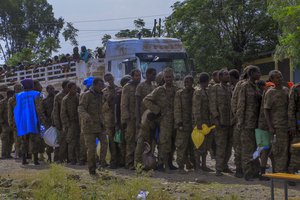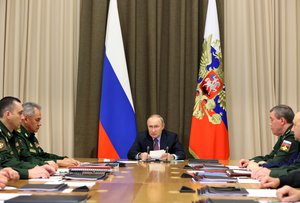Latest News for: verification
Edit
Govt Begins Mop-Up Biometric Verification of 21,000 Pensioners
All Africa 04 Nov 2021
The Pension Transitional Arrangement Directorate (PTAD), ...
Edit
The Verification & Validation Valley: Why Both are Critical in New Product Development (Proto Labs Inc)
Public Technologies 04 Nov 2021
). Desktop and In-House 3D Printing for Basic, Early Prototypes. One big reason why the term 3D printing is more widely recognized and commonly used than AM is because of the proliferation and popularity of inexpensive desktop 3D printers used by individual consumers, hobbyists, and STEM students ... Attachments Original document Permalink. Disclaimer.
Edit
TNAU To Conduct Document Verification In Offline Mode
NDTV 03 Nov 2021
The Tamil Nadu Agricultural University (TNAU) will be conducting the document verification round for candidates seeking admission under special reservation in offline mode ... .
Edit
$42 Billion Identity Verification Markets - Global Market Size & Forecasts to 2030: Growing Digitalization ...
Business Wire 03 Nov 2021
DUBLIN--(BUSINESS WIRE)--The "Identity Verification Market - Market Size & Forecasting (2018-2030)" ...
Edit
50 South Sudanese Military Commanders in Akobo Receive Child Protection Training, Request Verification of Barracks
APO 03 Nov 2021
When civil war broke out in South Sudan, education was disrupted for tens of thousands of children. Many were separated from their parents and, worse still, recruited into armed forces and groups themselves ... The long-term objective is for South Sudanese armed groups to be removed from what is known as the ‘list of shame.’ ... Media files ... .
Edit
Therap Interfaces with a New Electronic Visit Verification (EVV) Aggregator in Missouri for Verification of ...
MENA FN 02 Nov 2021
(MENAFN - PR Newswire) WATERBURY, Conn., Nov. 2, 2021 /PRNewswire/ -- Therap Services, the leading software solution for HIPAA-compliant electronic documentation for service providers in Home and ... .
Edit
Therap Interfaces with a New Electronic Visit Verification (EVV) Aggregator in Missouri for Verification of Home and Community-Based Services in compliance with the 21st Century Cures Act EVV Mandate
PR Newswire 02 Nov 2021
Users in Missouri can now benefit from this integration by utilizing the Therap system to directly submit Electronic Visit Verification (EVV) data obtained using Therap's EVV tools to the new interface ... EVV features also include point-of-service voice, photo and client signature verification options.
Edit
Taurus: Ask questions and insist on verification in writing
Lewiston Sun Journal 02 Nov 2021
CELEBRITIES BORN ON THIS DAY ... lang, 60; Stefanie Powers, 79. Happy Birthday ... .
Edit
Seattle to offer $1,000 grants to some businesses affected by vaccine verification
Business Journal 02 Nov 2021
Up to 2,000 small businesses and nonprofits will receive aid. Applications are open until Nov. 14 ... .
Edit
Bhubaneswar: Police ask bars in twin cities not to keep bouncers without verification
The Times of India 02 Nov 2021
BHUBANESWAR ... He has also it compulsory for the bar owners to get their police verification done before employing them. No bar owner shall appoint any person as a private security guard or bouncer without prior verification of their character and antecedents by the deputy commissioners of police ... Start a Conversation. .
Edit
 The Logan Daily News
02 Nov 2021
The Logan Daily News
02 Nov 2021
Social Security: Need a standardized benefit verification letter? Get it online
 The Logan Daily News
02 Nov 2021
The Logan Daily News
02 Nov 2021
If you need a Benefit Verification letter, sometimes called a “proof of income letter,” we have good news for you! Your Benefit Verification letter is available online when you need proof of Social Security benefits, Supplemental Security Income, or Medicare.
Edit
 Mount Carmel Register
02 Nov 2021
Mount Carmel Register
02 Nov 2021
UL and the Telecommunications Industry Association Announce SPIRE™ Smart Building Verifications Now Available
 Mount Carmel Register
02 Nov 2021
Mount Carmel Register
02 Nov 2021
NORTHBROOK, Ill. and ARLINGTON, Va., Nov.
Edit
Verification and Validation Assessments Complete (Memphasys Ltd)
Public Technologies 02 Nov 2021
). The text version of this document is not available ... Disclaimer. Memphasys Ltd.
Edit
 Finger Lakes Times
02 Nov 2021
Finger Lakes Times
02 Nov 2021
Metaverse Technologies Aims To Shape The Metaverse With M3TA's Dynamic NFT Verification
 Finger Lakes Times
02 Nov 2021
Finger Lakes Times
02 Nov 2021
M3TA's Dynamic NFT Verification is a new way to make NFTs practical for real world applications ... To learn more about Dynamic NFT Verification click here ... https.//www.prnewswire.com/news-releases/metaverse-technologies-aims-to-shape-the-metaverse-with-m3tas-dynamic-nft-verification-301413749.html.
Edit
Tabula Rasa Partners with TrackMy Solutions on Robust Vaccine Verification Management System
PR Newswire 02 Nov 2021
to provide opt-in and secure, verified vaccine status information for its TrackMy VeriVax vaccine verification management service ... "It is proving to be very challenging for organizations to manage the status and verification of COVID vaccines among employees," said Kelli ...
- 1
- 2
- Next page »
















